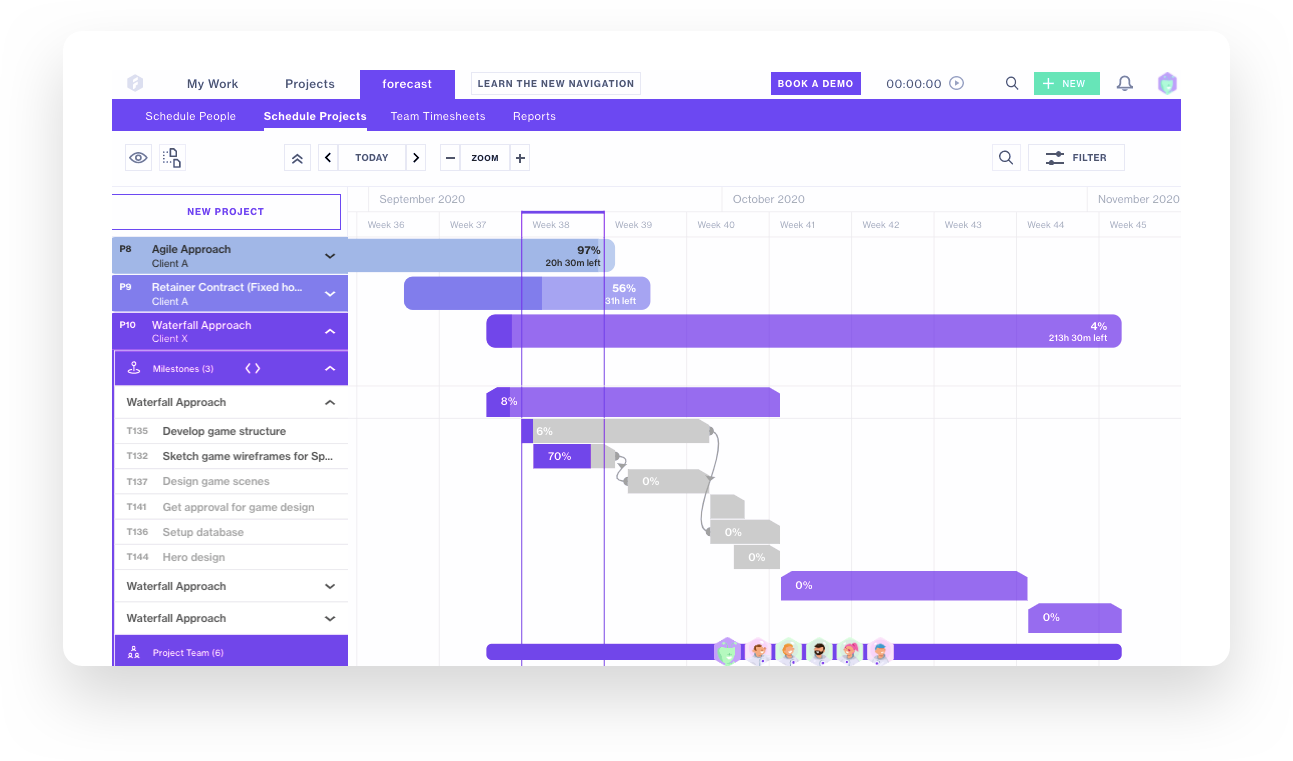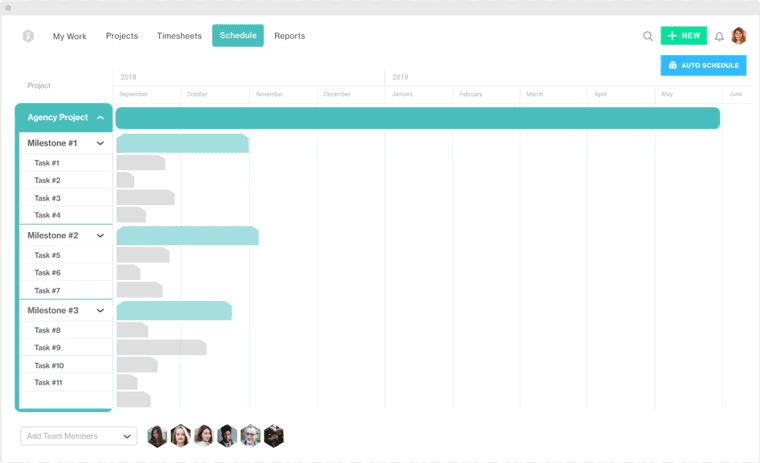Project Execution Do’s & Don’ts: 5 Key Lessons to Learn

Let’s talk about a scenario many seasoned project managers have either been a part of or are at least familiar with.
The project initiation and project planning phases go by the book, you develop a project plan that will even put the Wikipedia page to shame, but not too long into the project execution phase, you hear the first cracks. One thing leads to another and, before you know it, the domino effect is bulldozing your project. A dependency you did not think was a big deal causes one delay after another, some people get left on standby, while others are running late with their part of the project. As a result, the plan you initially developed is no longer relevant.
Weak project execution can often be the cause behind such an unfortunate turn of events. This is why being in control through the whole stage is paramount for project managers to get their projects to the finish line. If you want to take the driver’s seat and, most importantly, keep it all along the way, here are the project execution essentials you need to be aware of.
- What is project execution?
- Why do you need a project execution plan?
- Challenges in the project execution process
- Project execution do’s and don’ts
What is project execution?
Preceded by initiation and planning, project execution is the third phase in the traditional project lifecycle pattern most project managers adhere to. This is the point where you put your project charter on the table and get the ball rolling. You get to test your theories, apply strategies, and basically implement the project.
While effective project planning is crucial for project success, being able to execute the plan is even more important. Flawless project execution will require you to take control over project timelines, budgeting, team management, and stakeholder management. According to the PMI, the role of a project manager is more valuable than ever during project execution because there are lots of factors in play here. The list includes but is not limited to resource challenges, customer demand shifts, changes in the business, as well as many other external and internal forces that can derail a project’s benefits and cause challenges on the way towards project goals.
Why do you need a project execution plan?
Think of a project management execution plan as if it were your own blitzkrieg. You use rapid forces, striking tactics, and a lot of maneuvering to get your project from point A to point B with minimum losses and maximum gains. Although in most cases mistakes are going to sneak in, having a sample of your own project execution plan will help you bring those mistakes to a bare minimum.
In its essence, this plan stands for a detailed outline of the steps you and your team are going to take for the project to stay on track and get delivered within the budget and timeframe you initially planned. There are several components you need to address when devising your project execution methodology:
- Unpredictables: what do you do if something doesn’t go according to the plan? For instance, a team member gets sick or scope creep knocks on the door. Try calculating your project execution risk and working out backup plans in advance.
- Project deliverables: how will you review performance and progress, run regular checks to rule out any possibility of project error?
- KPIs: how will you know if the project is meeting the time and budget you allocated for it?
Challenges in the project execution process
A viable project execution plan will also help you go around what is often called strategic execution gaps or challenges, that can appear both on the company level and the project level. In a recent Project Management Podcast's feature interview, Paul Williams, Executive Managing Partner of Think For A Change LLC., commented on his recent article “Mind the Strategic Execution Gap" and explained the general idea of the notion as follows:
My definition is that it is the difference between what the organization should get done based on its strategy and what actually does get done based on what projects are actually funded and executed.
But what do strategy execution gaps mean for specific projects? In 2017, Todd Williams, Executive Consultant at eCameron Inc and a recognized project management author, published a book called Filling Execution Gaps. According to the author, these are the gaps project managers, middle managers, and even executives face on a daily basis when trying to direct and manage project execution. Here is “the big six”:
- No common understanding
- Uninvolved executive sponsors
- Poor alignment of strategic goals
- Unreliable change management
- Weak corporate governance
- Questionable leadership
Project execution do’s and don’ts
With all those challenges or gaps, if you will, in mind, one question stands strong: how to improve project execution and what mistakes to avoid on the way to successful project delivery? Here are some practice-based tips that might help you out in this.
DON’T assume that stakeholders will communicate with each other
Stakeholders, as the name suggests, are a group of people who have a stake or some specific interest in your project, company, or organization. They will be affected whether the project succeeds or fails. The PMI reports that poor communication acts as a contributing factor in 56% of failing projects. This is why keeping an eye on stakeholder involvement and communication is crucial during the execution phase in project management.
How do you know if your stakeholder communication is good enough? Try answering these questions:
- Does everyone in your team know what their colleague is focused on?
- Are all dependencies clear?
- Does your client know the current status of the project?
If your answer is ‘no’ or ‘not sure’ to any of the three questions, then good project execution software can help you make amends. Having access to a project timeline will give your team members a chance to know what others are doing and whether there are any delays that will impact their own scheduling. What’s more, you can also use the timeline view to track your project progress and update your clients or other external stakeholders about it. Just invite them to the platform or send them an automatically generated report. Here’s how that timeline view looks like in Forecast:

DO define clear responsibilities and accountabilities within your teams
In the given context, responsibilities will show you who in the team is responsible for delivering what task. Accountabilities are more general, they point at the person accountable for a certain decision, the person who needs to take ownership of deliverables or failures. If project responsibilities and accountabilities don’t get defined early on, the trap will snap shut the moment you run into the first brick wall and the blaming game will commence. But the problem is that many people forget about this part of project management after the preliminary phrases, which can fire back when you least expect it.
A typical project management execution process is rarely static, some tasks and priorities change, the scope gets adjusted. That is why you need to define responsibilities and accountabilities not only during the planning stage of your project but also all along its execution journey. If you take the time to communicate who is responsible and accountable for what part of the project, it will be easier for team members to communicate and cooperate more effectively. As a result, everyone will know what role they play in the project and what they need to do to see it succeed.
DON’T miss the slacker on the team
In an article for the PMI, Brownlee focuses on the most common mistakes beginner project managers make and talks about the Pareto Principle. In relation to project management, this principle means that 20% of the team are delivering 80% of the work. Reasons for such an unfair workload distribution usually vary, but there is one you need to look out for during the execution stage in project management: a slacker. In order not to compromise the morale of the team, let alone its productivity, project managers need to be in control of their resources, making sure not to leave anyone overbooked or undercooked.
Using relevant software for your chosen project execution methodology will give you access to a bird's-eye view of your resources and their availability. You can see what members of your team are in for extra hours and who is still available to take on additional tasks. What’s more, having people register time will help you track all billable and non-billable hours, understand what task takes how much time, and what pace is comfortable for every member of your team.
86f8.png)
DO check your project progress regularly
It feels like talks about real-time data have been around for ages in execution project management, yet when Wellingtone researched the matter in 2018 they found that 55% of organizations don’t have access to their real-time KPIs. Not to mention that the very same research found that many companies still build their project reports manually, which is a massive time waste in the age of automatization. What most project management connoisseurs might think at this point is “How do you track your real-time budget or project deliverables?” Well, you don’t. It is pretty much a blind spot.
The conclusion is probably self-evident at this point: the key to successful execution of project management lies in access to real-time data. When you know what is happening with your project at any given point in time, day and night, chances are low that you will run into unexpected surprises or bottlenecks. You can gather all the latest data in a single document to share it with relevant stakeholders by creating a Project Portfolio Report. One of the great things about this report is that you can customize it by adding or removing specific components depending on your needs or target audience. In a matter of seconds, you can learn the state of your project progress, scheduling, and even questions related to finances and budgeting.
DON’T be easy on scope creep
Scope creep stands for the new tasks, features, and requirements, you or your client add to the project after you have already launched it. All of these “updates'' usually translate into additional costs, lack of time, and resource constraints. While scope creep is a very familiar guest in project management, many experts still fail to plan their project execution process in such a way that it would leave no or very little room to scope creep. Jamal Moustafaev, President and CEO of Thinktank Consulting, uncovers the dangers of scope creep in a recent PM podcast:
If you dig deeper, you will discover that 5 out of 8 top reasons why projects fail are related to requirements and they include incomplete requirements, lack of user involvement, unrealistic customer expectations, changing requirements and specifications, customers no longer needing the features provided.
So what can you do to cut that scope creep out of your project management execution picture? Job number one here would be to have your project scope pre-defined during the initiation and planning phases and get the client or the stakeholders to agree on it. Next, to keep your scope under tight control during the execution phase of project management, consider using a collaborative project management platform that will connect the dots between your scoping, scheduling, budgeting, and time registration. For example, with Forecast, you can enjoy the AI add-ons like Auto Scheduling that redefine the tried and tested Gantt chart. Should something change in your scope, timing, or scheduling, the platform will automatically do the needed adjustments within a few seconds:

The project management execution process is always multi-faceted and inundated with stress factors. Managing everything manually, especially if your team comprises more than 10 members adds the unnecessary challenge you can otherwise avoid. If you feel like upgrading your project management protocols and introducing recognized project execution software to have a good grip on your projects, Forecast is just what you need. To learn how automation can redefine your project execution experience and then actually try it in action, feel free to book a demo and look at the tool from the inside!
You might like to read these articles on our blog..
Subscribe to the Forecast Newsletter
Get a monthly roundup of productivity tips & hacks delivered straight to your inbox
